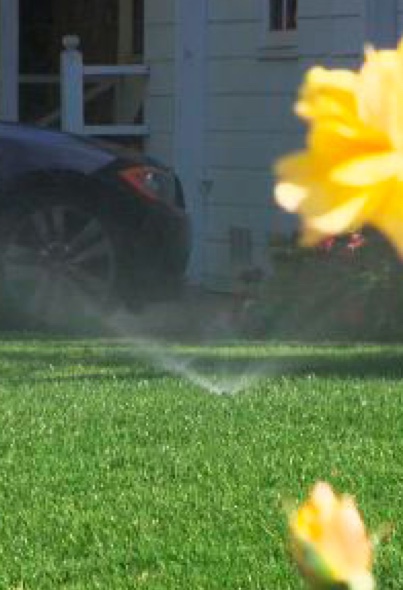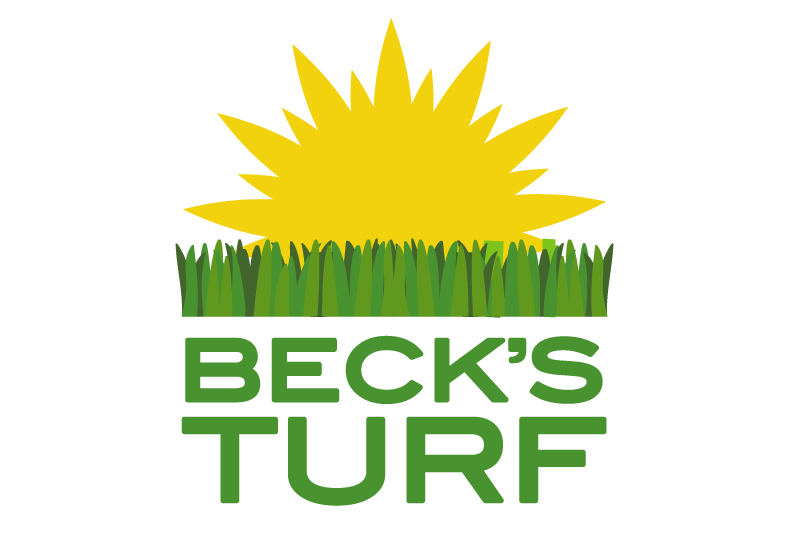Watering New Turfgrass Sod

Water is essential to all life…too little water and we die, too much and we drown. The same is true of the grass in our lawns. Water makes up 70-80% of the weight of our lawn grasses and the clippings are nearly 90% water. While most people are concerned about not watering their lawns enough, the fact is that more lawns are damaged or destroyed by over-watering.
The first watering of newly installed turfgrass sod is the most important. Begin watering IMMEDIATELY after installation of the new turfgrass. The first watering establishes how well the grass will perform for years to come. We usually recommend watering every day for the first 10 days.
It is essential to begin watering new turfgrass sod within a half-hour after it is laid on the soil. Apply at least 1 in of water so that the soil beneath the turf is very wet. Ideally, 3 to 4 inches below the soil should be moist.
When to Water New Turfgrass Sod - Tips
1
Pull back a corner of the turf and push a screwdriver or other sharp tool into the soil. It should push in easily and have moisture along the first 3-4 in. or you need to apply more water.
2
Make absolutely certain that the water is getting to all areas of your new lawn, regardless of the type of sprinkling system you use. Corners and edges are easily missed by many sprinklers and are particularly vulnerable to drying out faster than the center portion of your new lawn. Also, areas near buildings, dry out faster because of reflected heat and may require more water.
3
Runoff may occur on some soils and sloped areas before the soil is adequately moist. To conserve water and ensure adequate soak-in, turn off the water when runoff begins, wait 30 minutes to an hour and restart the watering on the same area, repeating as needed.
4
As the turf starts to knit its new roots into the soil, it will be difficult, impossible and/or harmful to pull back a corner to check beneath the turf (Watering Tip #1) but you can still use a sharp tool to check moisture depth by pushing it through the turf and into the soil.
5
Water as early in the morning as possible to take advantage of the daily start of the grass’s normal growing cycle, usually lower wind speeds and considerably less loss of water because of high temperature evaporation.
6
If the temperature approached 100°F or if high winds are constant for more than half of the day, reduce the temperature of the turf surface by lightly sprinkling the area. The sprinkling does not replace the need for longer, deeper watering, which will become even more critical to continue during adverse weather conditions.
7
Infrequent and deep watering is preferred to frequent and shallow watering because the roots will only grow as deeply as their most frequently available water supply. Deeply rooted grass has a larger “soil-water bank” to draw moisture from and this will help the grass survive drought and hot weather that rapidly dries out the upper soil layer.
How to Water
Proper watering techniques are a critical aspect of lawn watering, equal in importance to the issues of when to water and how much to water. Here are several key factors to proper technique:
Avoid hand sprinkling because it cannot provide the necessary uniformity. Most people do not have the patience, time or “eye” to adequately measure what is being applied across any large areas of lawn. The only possible exception to this guideline would be that the need to sprinkle the surface of the grass to cool it or to provide additional water near buildings or other heat-reflecting surfaces.
Understand the differences between sprinkler designs because each type has its advantages and disadvantages. Its proper use will be determined by the type of sprinkler you select.
Follow These Steps
Step 1
Arrange the cans at random distances away from any sprinkler, but all within the area you assume is being covered.
Step 2
Run the sprinkler for a specific amount of time, say a half-hour or run the water until a specific amount of water is in at least one can, say ½ in.
Step 3
Check water cans for uniformity. A variation greater than of 25-30% calls for replacing/adjusting the sprinkler system or relocating it.
In-Ground Systems require professional design, installation, and routine adjustments to be most efficient and effective. The greatest mistake made with most in-ground systems is the “set it and forget it” philosophy that fails to consider the changing seasonal water requirements or allowing the system to operate during/following a multi-inch rain storm. Another frequent problem is when heads get out of alignment and apply water to the sidewalk or other areas around the lawn.
Hose-End Sprinklers range in complexity, cost, and durability, but are highly portable and can provide uniform and consistent coverage when properly placed and adequately maintained.
Sprinklers that do not throw the water high into the air are usually more efficient, as are larger drop generators because prevailing winds are less disruptive or distribution patterns, potential for evaporation loss is reduced and trees, shrubs, and other plants do not block the pattern (or are very noticeable if they do).
Several times during the growing/watering season, routine maintenance is important to check for blocked outlets, leaking or missing gaskets, or misaligned sprinkler heads regardless of the sprinkler design.
Verifying watering uniformity can be accomplished with a very simple and inexpensive method that uses only 4 to 6 flat bottomed straight sided cans (tuna, cat food, etc.) a ruler and a watch.
For areas around trees, remember water requirements for the specific trees as well as the grass. Despite having deep “anchor” roots, trees take-up moisture and nutrients from the same top six inches of soil as the grass, causing trees and turf to compete. Watering sufficiently for the grass may over/under water some varieties of trees. A common solution is to not plant grass under the drip line of trees, but rather use those areas for perennial ground covers, flower beds or mulch beds.
How Much Water is Needed/Applied

The amount of water your lawn requires and receives will determine its overall health, beauty, and ability to withstand use and drought. Keep in mind that too much water can ruin a lawn just as fast as too little water.
One inch a week is a watering rule of thumb suggested for most lawns; however, this will vary within a species. There will also be varying water requirements for seasonal change and still more differences due to different soil types.
Look at your lawn to determine its needs. Grass in need of water will appear grey-blue rather than blue-green or green. Also, footprints will still appear after a half-hour or more on a lawn in need of water, while on a well watered lawn, footprints will completely disappear within a few minutes. Inspecting your lawn frequently will help you detect water requirements and avoid over or under watering.
Verify watering quantities with the same measuring method described above except you will want to note the time it takes for the cans to collect a specific amount of water. For example, if ¼ inc collect in 30 minutes you can easily calculate that it will take on hours to apply ½ in. of water and two hours to apply 1 in.
Water timers can help provide consistency and even be programmed or set to turn on and off when no one is awake or at home. Some timers measure just the amount of time water is flowing through the device, while others measure the number of gallons of water flowing through it. Read the directions with the timer to determine how yours operates.
